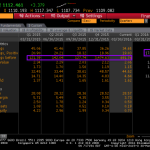One of the great ironies of QE is that while the post-crisis monetary policy regime was designed and implemented to reflate the global economy, there are certain places where these policies are actually deflationary.
And when you think about it, it’s common sense. If you artificially suppress borrowing costs and distort the supply/demand dynamics in the fixed income market in order to engineer a hunt for yield, what you invariably end up doing is creating a “zombie” dynamic whereby otherwise insolvent companies are kept in something akin to suspended animation by virtue of wide-open capital markets.
This is part and parcel of the whole “up the down escalator” dynamic in the oil market. Uneconomic U.S. production was allowed to effectively hibernate during the price downturn thanks in part to the fact that capital markets never completely slammed shut and then when prices began to rise again, producers found markets even more willing to keep the spigots open thus encouraging still more production.
This is the dynamic that led Anadarko boss Al Walker to liken his own industry to a gang of hopeless alcoholics last year.
“The biggest problem our industry faces today is you guys,” Walker told investors at a conference last June. “It’s kind of like going to AA. You know, we need a partner. We really need the investment community to show discipline.”
Of course, you can’t expect the investment community to “show discipline” in an environment where yield is an endangered species. The relentless chase down the quality ladder catalyzed by central banks dumping $15 trillion-ish at the top of that same ladder ensures that everything gets priced to perfection on the way down, with the sole exception of companies that are on the verge of default. Recall this schematic from Citi:

This raises questions about what happens when the accommodation that creates that dynamic fades or, more to the point, when central banks start to wind down their balance sheets. What happens to the zombies (so to speak)?













Leave A Comment